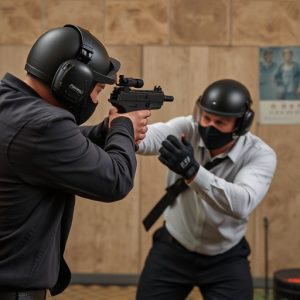Taser vs Stun Gun: Uncovering Key Differences & Buying Tips
When purchasing a stun gun, consider its range (shorter than Tasers), power output (higher voltage f…….
When purchasing a stun gun, consider its range (shorter than Tasers), power output (higher voltage for better penetration), safety features (switches, training modes), portability (weight, size, ease of use), and understand legal aspects. Look for clear activation mechanism, ease of use, battery life, warranty, and safety features to prevent accidental discharge while prioritizing compliance with local laws regarding open or concealed carry.
“Unraveling the mysteries of self-defense tools, this article takes an in-depth look at Tasers and stun guns—their unique capabilities and distinct differences. From understanding their mechanisms to exploring key distinctions in performance and effectiveness, we guide you through the process of making an informed decision.
Learn what sets these devices apart, what factors to consider during purchase, and essential legal guidelines for responsible ownership. Discover what to look for when buying stun guns to ensure a safe and effective self-defense choice.”
- Understanding Tasers and Stun Guns: A Comprehensive Overview
- Key Differences: How They Work and Their Effectiveness
- What to Consider When Choosing Between the Two
- Legal Aspects and Safety Guidelines for Purchase and Use
Understanding Tasers and Stun Guns: A Comprehensive Overview

Tasers and stun guns are non-lethal weapons designed to incapacitate individuals, but they operate on different principles and have distinct features. Tasers, officially known as Electronic Control Devices (ECDs), use electrical current to disrupt muscle control, causing temporary paralysis. They typically fire two small probes connected to the device by thin wires, delivering a high-voltage, low-current electric shock. Stun guns, on the other hand, emit a strong electrical pulse of high voltage and low current through a metal probe or bar, temporarily disrupting nerve signals and causing muscle spasms.
When considering what to look for when buying stun guns, several factors are essential. First, understand the range: stun guns often have a shorter effective range compared to tasers. Next, consider power output: higher voltage ensures better penetration through clothing or barriers. Safety features like safety switches and training modes can be beneficial, especially for non-lethal self-defense purposes. Additionally, weight, size, and ease of use are crucial for portability and quick deployment.
Key Differences: How They Work and Their Effectiveness

When considering purchasing a stun gun or Taser, understanding the key differences between them is essential. Both devices are designed to incapacitate an attacker but operate on different principles. A stun gun delivers an electric shock through metal prongs that make contact with the target’s skin, disrupting muscle control and causing temporary paralysis. This method ensures direct contact and can be effective at close range.
On the other hand, a Taser uses two probes connected to wires to deliver an electric pulse between them, creating a powerful jolt that overrides the body’s motor functions. Tasers are known for their longer range and ability to disable multiple attackers simultaneously. When looking for stun guns, what to consider includes power, range, and safety features, as understanding these devices’ distinct functionalities is vital for effective self-defense.
What to Consider When Choosing Between the Two

When choosing between a taser and a stun gun, there are several key factors to consider. Firstly, understand the purpose for which you need the device; tasers are designed for law enforcement and self-defense scenarios involving aggressive or violent individuals, while stun guns are more suitable for personal protection against unexpected attacks. Secondly, look at their operating mechanisms: tasers use electrical current to disrupt muscle control, while stun guns emit a powerful electric shock through metal prongs.
Additionally, when buying stun guns, what to look for includes power and voltage—higher values offer more effectiveness but also increase safety concerns. Range is another critical consideration; some devices have a shorter reach, making them ideal for close encounters, while others boast longer ranges. Portability and ease of use are also essential, especially if you plan to carry it regularly. Always consider safety features such as over-current protection and automatic shut-off mechanisms to prevent accidental or uncontrolled activation.
Legal Aspects and Safety Guidelines for Purchase and Use

When considering the purchase of a stun gun or Taser, it’s crucial to understand the legal aspects and safety guidelines that govern their use. Legality varies by region, so what’s important is to research and comply with local laws. Some areas allow the open carry of stun guns, while others restrict them to concealed carry only. Check with your state or provincial authorities for specific regulations.
Before buying, focus on what to look for when buying stun guns. Ensure the device has a clear activation mechanism and is easy to use in stressful situations. Check battery life and warranty, as well as any safety features designed to prevent accidental discharge. It’s also vital to follow manufacturer guidelines and safe handling practices to ensure personal safety and comply with legal requirements.
When choosing between a Taser and a stun gun, understanding their distinct mechanisms and considerations is key. Both devices offer personal protection, but they differ in power, range, and impact. Tasers use electric current to disrupt muscle control, while stun guns employ high-voltage, low-current electrical pulses to temporarily disable. When buying a stun gun, consider factors like power output, voltage, reach, and safety features. Additionally, familiarize yourself with local laws and guidelines for responsible ownership and use. By weighing these aspects, you can make an informed decision, ensuring you’re prepared and safe in case of emergencies. Remember, what you choose should align with your needs, preferences, and the legal framework in your region.


